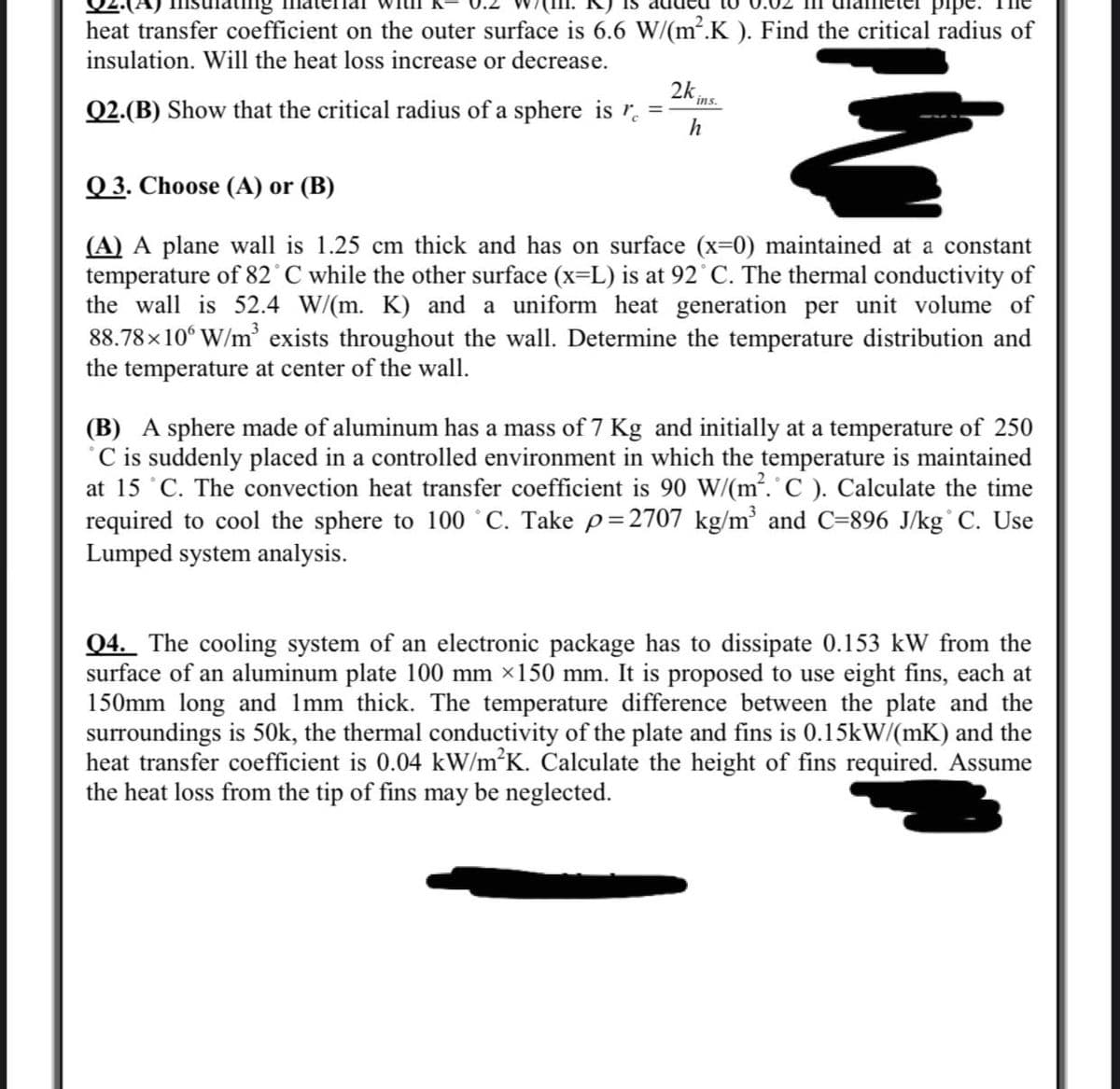U.2 W(III. K) IS auutu to 0.UZ II dlalIcter pipe. TIHE ZAJMIsulating Iaterial wiuI K heat transfer coefficient on the outer surface is 6.6 W/(m2.K ). Find the critical radius of 2k ins. insulation. Will the heat loss increase or decrease. Q2.(B) Show that the critical radius of a sphere is r. =
U.2 W(III. K) IS auutu to 0.UZ II dlalIcter pipe. TIHE ZAJMIsulating Iaterial wiuI K heat transfer coefficient on the outer surface is 6.6 W/(m2.K ). Find the critical radius of 2k ins. insulation. Will the heat loss increase or decrease. Q2.(B) Show that the critical radius of a sphere is r. =
Principles of Heat Transfer (Activate Learning with these NEW titles from Engineering!)
8th Edition
ISBN:9781305387102
Author:Kreith, Frank; Manglik, Raj M.
Publisher:Kreith, Frank; Manglik, Raj M.
Chapter7: Forced Convection Inside Tubes And Ducts
Section: Chapter Questions
Problem 7.29P
Related questions
Question
i need the answer quickly

Transcribed Image Text:heat transfer coefficient on the outer surface is 6.6 W/(m².K ). Find the critical radius of
insulation. Will the heat loss increase or decrease.
2k,
Q2.(B) Show that the critical radius of a sphere is r. =
h
ins.
Q 3. Choose (A) or (B)
(A) A plane wall is 1.25 cm thick and has on surface (x=0) maintained at a constant
temperature of 82°C while the other surface (x-L) is at 92 C. The thermal conductivity of
the wall is 52.4 W/(m. K) and a uniform heat generation per unit volume of
88.78x10° W/m exists throughout the wall. Determine the temperature distribution and
the temperature at center of the wall.
(B) A sphere made of aluminum has a mass of 7 Kg and initially at a temperature of 250
C is suddenly placed in a controlled environment in which the temperature is maintained
at 15 °C. The convection heat transfer coefficient is 90 W/(m². C ). Calculate the time
required to cool the sphere to 100 °C. Take p=2707 kg/m³ and C=896 J/kg C. Use
Lumped system analysis.
Q4. The cooling system of an electronic package has to dissipate 0.153 kW from the
surface of an aluminum plate 100 mm ×150 mm. It is proposed to use eight fins, each at
150mm long and Imm thick. The temperature difference between the plate and the
surroundings is 50k, the thermal conductivity of the plate and fins is 0.15kW/(mK) and the
heat transfer coefficient is 0.04 kW/m°K. Calculate the height of fins required. Assume
the heat loss from the tip of fins may be neglected.
Expert Solution
This question has been solved!
Explore an expertly crafted, step-by-step solution for a thorough understanding of key concepts.
Step by step
Solved in 2 steps with 3 images

Knowledge Booster
Learn more about
Need a deep-dive on the concept behind this application? Look no further. Learn more about this topic, mechanical-engineering and related others by exploring similar questions and additional content below.Recommended textbooks for you

Principles of Heat Transfer (Activate Learning wi…
Mechanical Engineering
ISBN:
9781305387102
Author:
Kreith, Frank; Manglik, Raj M.
Publisher:
Cengage Learning

Principles of Heat Transfer (Activate Learning wi…
Mechanical Engineering
ISBN:
9781305387102
Author:
Kreith, Frank; Manglik, Raj M.
Publisher:
Cengage Learning